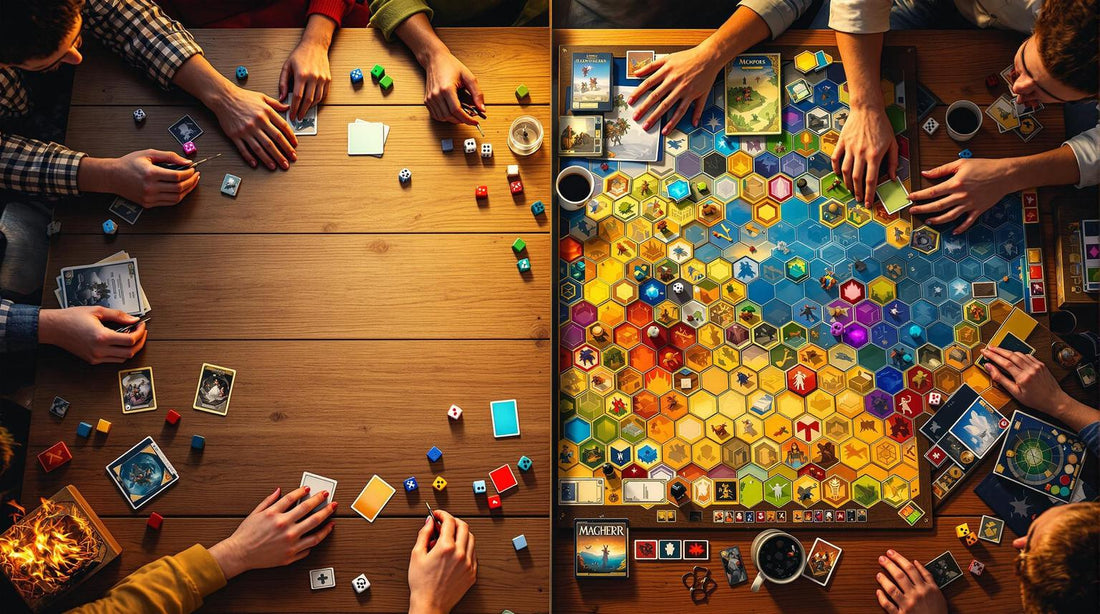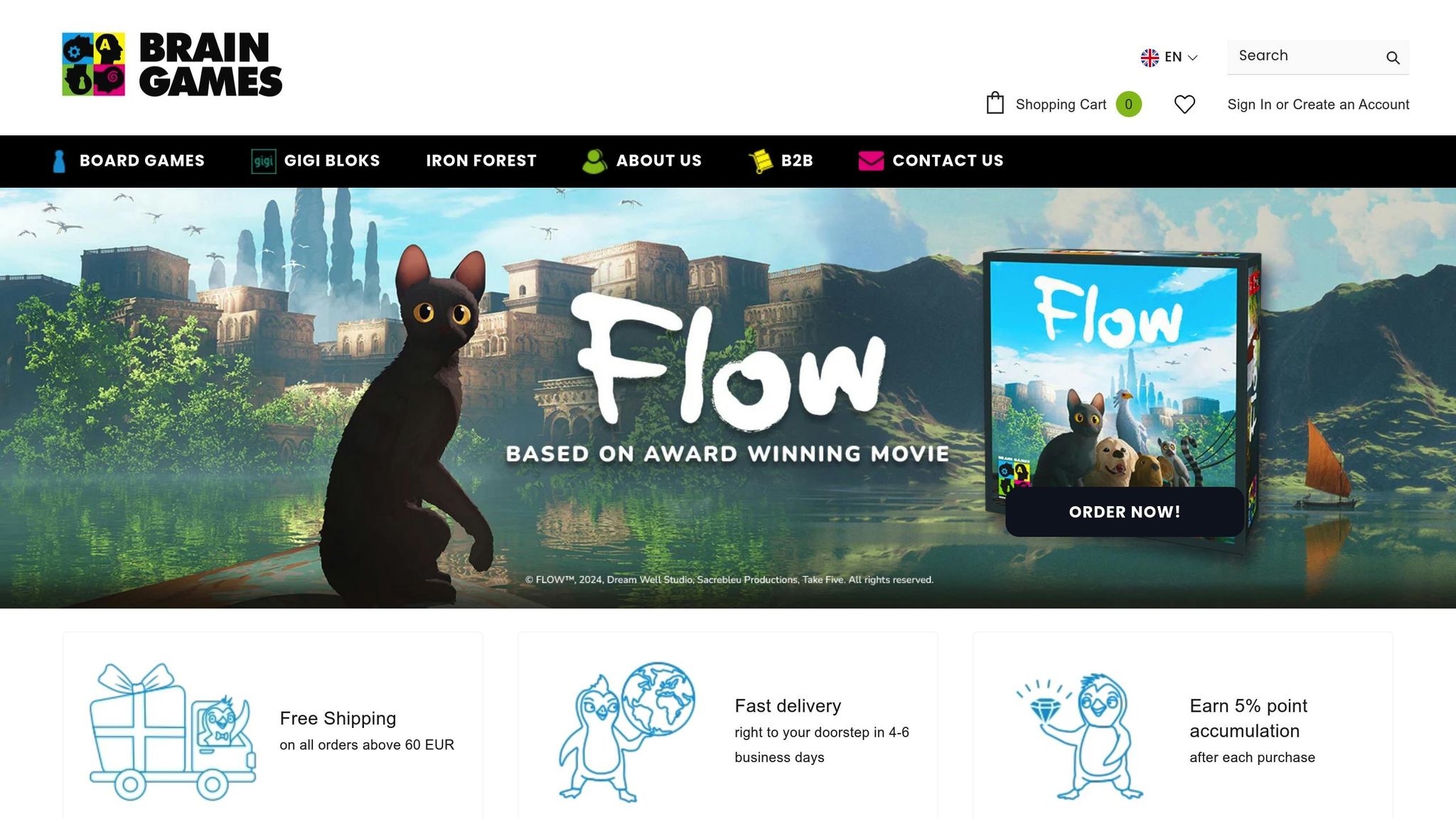Discover the Best Board Games for Every Player

Classic Games vs Modern Games: Key Differences
Classic and modern board games offer distinct experiences, catering to different preferences. While classics like Chess and Monopoly focus on simplicity and direct competition, modern games such as Terraforming Mars and Pandemic emphasize complex strategies, dynamic mechanics, and cooperative play.
Key Differences at a Glance:
- Game Design: Classics are simple and quick to learn; modern games are intricate and immersive.
- Game Mechanics: Classics use fixed setups; modern games feature variable boards and roles.
- Player Interaction: Classics focus on rivalry; modern games often encourage teamwork.
- Replay Value: Classics rely on consistent rules; modern games use expansions and evolving systems.
- Target Audience: Classics appeal to everyone; modern games cater to niche groups.
- Game History: Classics are time-tested; modern games evolve through crowdfunding and online communities.
Quick Comparison:
| Aspect | Classic Games | Modern Games |
|---|---|---|
| Complexity | Simple, easy to learn | Complex, detailed systems |
| Mechanics | Fixed setups | Variable setups, dynamic roles |
| Interaction | Competitive | Cooperative or mixed styles |
| Replayability | Static rules | Expansions, evolving gameplay |
| Audience | Broad, family-friendly | Niche, interest-specific |
| Development | Mass-market focus | Community-driven, crowdfunded |
Both styles have their strengths, making them valuable for different occasions and player preferences. Keep reading to explore these differences in detail!
Modern & Classic Board Game Equivalents - Evolution of Board Games
Game Design: Simple vs Complex
The main difference between simple and complex games lies in their core design philosophies. A 2019 study on BoardGameGeek illustrated this contrast: while new players can grasp Chess rules in about 10 minutes, learning the rules for Gloomhaven takes closer to 2 hours.
Classic Games: Straightforward Rules and Quick Learning
Classic games stand out due to their simplicity and ease of learning. Their design often focuses on:
- Clear objectives, like capturing the king in Chess
- Limited player actions, such as rolling dice and moving in Monopoly
- Relatable themes, which connect to everyday concepts
Take Monopoly as an example. Its 1,500-word rulebook makes the game accessible while still offering layers of strategy. Similarly, Chess has captivated players for centuries with its profound strategic depth, all built on a foundation of simple movement rules.
Modern Games: Complex Systems and Immersive Themes
Modern board games, on the other hand, lean into complexity as a strength. They build depth through features like:
- Interconnected systems
- Resource management
- Unique player abilities
- Strongly tied themes and mechanics
For example, Terraforming Mars blends resource management, card synergies, and multiple paths to victory, creating a rich strategic experience. Similarly, Wingspan integrates bird species' traits into its gameplay mechanics, offering an immersive experience that prioritizes theme but can be harder for new players to pick up.
Although the complexity of modern games can be overwhelming at first, many now include modular rules and adjustable difficulty levels. These features allow for more strategic choices and diverse gameplay, appealing to a wide range of players.
Game Mechanics: Fixed vs Changing
Classic and modern games take very different approaches to how they function, reflecting their distinct design philosophies. These differences shape the overall gameplay experience and play a key role in the strategic depth we explored earlier in the Game Design analysis.
Classic Games: Set Paths and Dice Rolls
Classic games rely on fixed mechanics. For example, Chess uses a static 64-square board, while Snakes and Ladders determines progress through dice rolls. While these mechanics offer simplicity, they can lead to repetitive gameplay over time.
Modern Games: Changing Boards and Player Roles
Modern games, on the other hand, introduce more dynamic mechanics, creating fresh experiences with every playthrough. These elements address the predictability found in classic games and open up new strategic possibilities.
Here are some of the key mechanics found in modern games:
| Mechanic | What It Brings to the Table |
|---|---|
| Variable Setup | Resources and layouts change each game |
| Unique Player Powers | Players have distinct abilities for their roles |
| Campaign System | Components evolve permanently across sessions |
Player Interaction: Fighting vs Working Together
The way players engage with each other reveals a major shift between older and newer board games. This change in social dynamics ties closely to the increased complexity found in modern game mechanics.
Classic Games: Head-to-Head Competition
Older board games often revolve around direct competition. Players aim to outwit or overpower their opponents using aggressive strategies. Here are a few well-known examples:
| Classic Game | Competitive Element |
|---|---|
| Scrabble | Blocking opponents while scoring high-value words |
| Risk | Dominating territories through conquest |
| Sorry! | Sending opponents' pieces back to the start |
These games are built for rivalry, often leading to clear winners and losers. The mechanics focus on creating tension between players rather than fostering collaboration.
Modern Games: Teamwork and Shared Goals
Modern board games have embraced cooperative play, offering experiences where players work together toward a common goal. Pandemic (2008) is a standout example, with its premise of players teaming up to stop global outbreaks.
Different cooperative styles have emerged in these games:
| Interaction Type | Example & Feature |
|---|---|
| Full Cooperation | Pandemic - Players unite to tackle a worldwide health crisis |
| Semi-Cooperative | Dead of Winter - Survive as a group, but with hidden personal motives |
| Team-Based | Codenames - Teams compete, but collaborate internally |
| Hidden Traitor | Battlestar Galactica - A mix of teamwork and potential sabotage |
This shift keeps everyone involved, even late into the game, appealing to those who enjoy shared experiences over direct competition.
While cooperative play has gained traction, many modern games mix both competitive and collaborative elements. These hybrid designs highlight how modern games offer more flexibility compared to the rigidly competitive nature of classic titles.
Replay Value: Fixed Setup vs Add-ons
How games keep players coming back session after session showcases a major difference between classic and modern board games. This shift from static to dynamic design also ties into the trend toward collaborative play in modern games.
Classic Games: Set Rules, Same Setup
Classic games focus on depth rather than variety to stay engaging. Take Chess, for example: its 64 squares and fixed piece placement remain the same, but the strategic possibilities are endless.
These games create replay value by leaning on:
| Aspect | How It Works |
|---|---|
| Strategic Depth | Mastery of fixed rules |
| Random Elements | Simple chance mechanics |
| Social Interaction | Opponent-driven unpredictability |
In essence, classic games rely on the players themselves to create variety, rather than changing the game components.
Modern Games: Extra Content and Random Setup
Modern board games take a completely different route to keep things interesting. According to surveys, 78% of board game fans say "high replayability" is a key factor when buying a game. Designers meet this demand by introducing mechanisms that ensure no two games feel the same.
Take Terraforming Mars, for instance. It uses variable player powers, random card draws, and expansion packs to offer new challenges every time.
A standout example of modern replayability is legacy games like Pandemic Legacy. These games permanently alter their components as you play, creating a unique experience every time and even spawning a whole new genre.
Modern games achieve replayability through features like:
| Feature | Purpose | Example |
|---|---|---|
| Customizable Components | Creates different setups for each game | Root's asymmetric factions |
| Variable Powers | Gives players unique abilities | Root's asymmetric factions |
| Expansions | Adds new content to explore | Ticket to Ride map collections |
| Scenario-based Play | Offers structured, varied gameplay | Gloomhaven's 95 scenarios |
The difference is clear: classic games challenge players to master consistency, while modern games keep things fresh with evolving systems and content.
sbb-itb-1ed942f
Target Players: Mass Market vs Specific Groups
Classic and modern games take different paths when it comes to engaging their audiences, showcasing their distinct design philosophies. This divide ties back to the mechanics and replay value we touched on earlier. Classic games aim for broad appeal, while modern games zero in on specific player groups - a contrast that shapes how players interact with each type.
Classic Games: Designed for Everyone
Classic board games focus on being easy to pick up and enjoyable for a wide range of players. Monopoly, for instance, has sold over 275 million copies globally. These games succeed by emphasizing:
| Feature | Example |
|---|---|
| Easy-to-Learn Rules | Scrabble's word-building simplicity |
| Themes for All Ages | Clue's engaging mystery-solving |
| Accessibility | Widely available in major stores |
| Budget-Friendly Pricing | Typically priced under $30 |
Modern Games: Tailored for Specific Interests
Modern games, on the other hand, cater to defined player groups and preferences. With 30% of players falling into the 18-34 age range, these games thrive by offering niche experiences through unique themes, longer playtimes, and specialized mechanics.
| Target Group | Game Example | Key Features |
|---|---|---|
| Strategy Fans | Twilight Imperium | Long, in-depth gameplay (4-8 hours) |
| Nature Lovers | Wingspan | Focus on bird species and scientific details |
| Cooperative Gamers | Pandemic | Team-oriented challenges |
| Solo Players | Gloomhaven | Rich single-player campaigns |
This focused approach benefits from strong support within gaming communities and direct feedback from players.
Game History: Old vs New
The shift from widely popular classics to more specialized modern games is rooted in changes to how games are developed and distributed.
Classic Games: Time-Tested Favorites
Classic board games have influenced gaming culture for centuries. Take the Royal Game of Ur, for example - dating back to 2600 BCE, it’s one of the oldest known board games. These early games introduced ideas that would later be reimagined by contemporary designers.
A key moment in classic gaming history was Parker Brothers' 1935 acquisition of Monopoly, which highlighted the focus on mass-market appeal through centralized publishing.
| Era | Notable Publishers | Key Contributions |
|---|---|---|
| Pre-1900s | Traditional Craftsmen | Hand-crafted chess sets, wooden boards |
| 1900-1950 | Parker Brothers, Milton Bradley | Mass-market distribution, standardized rules |
Modern Games: Online Communities and Crowdfunding
The modern board game scene has been transformed by digital tools and community-driven platforms. One standout example is Kickstarter, where tabletop games raised a staggering $236.6 million in 2020 alone.
Modern game development has embraced three major innovations:
| Innovation | Impact |
|---|---|
| Crowdfunding | Allowed niche game ideas to thrive |
| Digital Tools | Made rapid prototyping more accessible |
| Online Platforms | Fostered direct communication between players and designers |
Online communities have also played a huge role in reshaping game development. Platforms like BoardGameGeek and Reddit offer spaces for strategy discussions, reviews, and direct feedback between players and creators. This kind of engagement supports the targeted approaches explored in the Target Players section.
Games at Brain Games

The shift from mass-market classics to modern, specialized games is evident in stores like Brain Games. Their collection highlights how traditional and contemporary gaming styles can thrive side by side.
Classic Games Collection
Brain Games offers a carefully curated selection of timeless classics, emphasizing designs that balance simplicity with lasting appeal. These games are chosen for their accessibility and nostalgic charm.
| Gaming Era | Design Focus |
|---|---|
| Classic Games | Family-friendly staples |
| Abstract, strategy-based play | |
| Modern Games | Diverse mechanics |
| Cooperative, story-driven play |
Modern Games Selection
Brain Games’ modern collection showcases the evolution of game mechanics, with titles that push boundaries and explore new ways to engage players. Their range includes games that appeal to fans of both traditional and cutting-edge designs.
To enrich the gaming experience, Brain Games focuses on:
- Community involvement, using feedback to shape their selection.
- Gameplay sessions, offering players a chance to explore games from both eras.
- Clear organization, making it easy to explore different design styles.
This thoughtful blend of classic and modern games mirrors the industry’s ongoing transformation, while ensuring quality and player enjoyment remain at the forefront.
Conclusion: Classic and Modern Games Today
Through six key comparisons, it's clear that classic and modern games both have a place in today's thriving tabletop scene. They cater to different player preferences, standing apart in their design, interaction, and ease of access.
Modern games have come a long way from their classic predecessors. They bring new mechanics and more complex strategies to the table, all while keeping the social connection that makes gaming special. The digital integration mentioned in the Game History section has also enriched both styles, especially during the recent boom in board game popularity.
These advancements combine the simplicity of classic games with the creativity of modern ones, reflecting the evolution seen in their unique takes on strategy, components, and player interaction.
FAQs
Which board game is better than Monopoly?
Modern board games bring new approaches to game design, offering a fresh take compared to Monopoly's limited strategy and competitive gameplay. Many of these games tackle the issues highlighted earlier, such as overly aggressive competition and predictable outcomes.
Here’s what they bring to the table:
- Shorter playtimes, typically lasting 30-90 minutes
- Varied ways to win, keeping the game dynamic
- Features that prevent runaway leads, ensuring fair play
- Engaging mechanics that keep all players involved throughout
If you enjoy Monopoly's focus on economic strategy, you'll find plenty of newer games that still include property management but with added layers of strategy and engagement.






